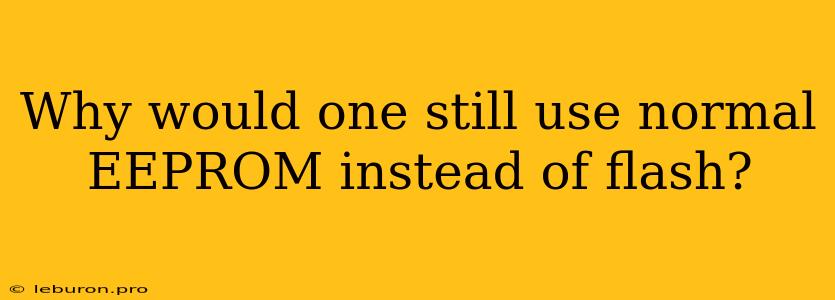While flash memory has become the dominant storage solution for a wide range of applications, there are still scenarios where traditional EEPROM (Electrically Erasable Programmable Read-Only Memory) holds advantages. The choice between EEPROM and flash depends on factors like write endurance, cost, and specific application requirements. This article explores why developers might opt for EEPROM despite the prevalence of flash memory.
Endurance and Write Cycles: EEPROM's Strength
One of the key advantages of EEPROM over flash is its superior write endurance. EEPROM memory cells are designed to withstand a significantly higher number of write cycles before degradation. This translates to a longer lifespan, making EEPROM ideal for applications requiring frequent data updates or those with strict reliability demands. Flash memory, in contrast, has a limited number of write cycles, and its performance can degrade over time, particularly when subjected to frequent writes.
Examples:
- Industrial Automation: In industrial environments where sensors and control systems require constant data logging, EEPROM's high write endurance ensures reliable and consistent data storage.
- Embedded Systems: EEPROM is often used in embedded systems like medical devices, automotive controllers, and industrial equipment, where data integrity and reliability are paramount.
Cost Considerations: Balancing Performance and Budget
While EEPROM boasts high write endurance, it generally comes at a higher cost compared to flash memory. This is due to the more complex manufacturing process required for EEPROM cells. In cost-sensitive applications, flash memory might be a more suitable option, particularly if the write frequency is relatively low.
When Cost Matters:
- Consumer Electronics: Flash memory's lower cost makes it the preferred choice for consumer devices like smartphones, tablets, and cameras, where high write endurance is not a critical requirement.
- Data Logging: In applications where infrequent data updates are sufficient, flash memory can provide a cost-effective solution for data storage.
Access Speed and Performance: Flash Takes the Lead
Flash memory generally offers faster read and write speeds compared to EEPROM. This performance advantage is particularly noticeable in applications demanding high data throughput, like multimedia storage and system boot processes.
Flash's Speed Advantage:
- Multimedia Storage: Flash memory's speed allows for quick access to large media files, making it ideal for storing photos, videos, and music.
- System Boot: Flash memory's fast read speeds enable rapid system boot times, enhancing the user experience.
EEPROM's Niche: Specific Applications and Advantages
While flash memory has become the dominant storage technology, EEPROM continues to hold its ground in niche applications where its unique characteristics are crucial. Here are some specific areas where EEPROM shines:
- Security Applications: EEPROM's inherent resistance to data corruption makes it suitable for storing sensitive data, such as cryptographic keys and authentication information.
- Non-Volatile Data Storage: In applications requiring persistent data storage even in the absence of power, EEPROM offers a reliable solution.
- Data Integrity: EEPROM's high write endurance and data retention capabilities make it an ideal choice for applications where data integrity is paramount.
Conclusion: Choosing the Right Memory Solution
The decision between EEPROM and flash ultimately comes down to the specific application requirements. For applications demanding high write endurance, long lifespan, and data integrity, EEPROM is a strong contender. Its high cost might be a factor, but its benefits outweigh the cost in certain scenarios. Conversely, flash memory excels in applications emphasizing speed, cost-effectiveness, and large storage capacities.
By carefully considering the key factors outlined above, developers can choose the memory technology best suited to their needs, ensuring optimal performance and reliability for their projects.
